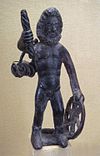Litavis
Litavis (Gaulish: Litauī 'Earth', lit. 'the Broad One')[1][2] is a Gallic deity whose cult is primarily attested in east-central Gaul during the Roman period.[1] She was probably originally an earth-goddess.[2][1][3] In medieval Celtic languages, various terms derived from *Litauia came to designate the Brittany Peninsula.[2]
Epigraphic evidence

Her name is found in inscriptions found at Aignay-le-Duc and Mâlain of the Côte-d'Or, France, where she is invoked along with the Gallo-Roman god Mars Cicolluis in a context which suggests that she might have been his consort.[citation needed] Also, a Latin dedicatory inscription from Narbonne (which was in the far south of Gaul), France, bears the words "MARTI CICOLLUI ET LITAVI" ("To Mars Cicolluos and Litavis").[4][5]
Name
Etymology
The Gaulish divine name Litauī ('Earth', lit. 'the Vast One') likely stems from Proto-Celtic *flitawī ('broad'; cf. Old Breton litan, Middle Welsh llydan, 'broad'),[6] ultimately from Proto-Indo-European *Pleth2-wih1 ('the Broad One'; cf. Sanskrit Pṛthvī, Greek Plátaia; also Old Norse fǫld, 'earth').[1][2][7][3]
The Gaulish personal name Litauicos ('sovereign', lit. 'possessor of the land') is also cognate with the Welsh Llydewig, meaning 'pertaining to Brittany', pointing to a Proto-Celtic term *Litauī-kos, here attached to the determinative suffix -kos.[1]
Medieval terms
The medieval or 'neo-Celtic' names for the Brittany Peninsula (cf. Old Irish Letha, Old Welsh Litau, Old Breton Letau, Latinized as Letavia) all stem from an original *Litauia, meaning 'Land' or 'Country'.[2] In the Irish Lebor Bretnach (11th c.), Bretain Letha means 'Britons of the Continent or Armorica, i.e. Bretons.' Linguist Rudolf Thurneysen proposed a semantic development from an Ancient Celtic term meaning 'broad land, continent' into the Insular Celtic names for the part of the Continent nearest the British Islands.[1]
References
- ^ a b c d e f g Koch 2006, p. 1159.
- ^ a b c d e Delamarre 2003, pp. 204–205.
- ^ a b West 2007, pp. 177–178.
- ^ Koch, John T. "Ériu, Alba, and Letha: When Was a Language Ancestral to Gaelic First Spoken in Ireland?" Emania: Bulletin of the Navan Research Group 9 (1991): 17–27.
- ^ Barbet, Gérald; Billerey, Robert. "Une plaque de bronze avec dédicace découverte en Franche-Comté". In: Gallia, tome 61, 2004. p. 286. DOI: https://doi.org/10.3406/galia.2004.3065; www.persee.fr/doc/galia_0016-4119_2004_num_61_1_3065
- ^ Bader, Françoise. "Les grands de l'Iliade et les Achéménides". In: Revue des Études Grecques, tome 112, Juillet-décembre 1999. p. 375. DOI: https://doi.org/10.3406/reg.1999.4376; www.persee.fr/doc/reg_0035-2039_1999_num_112_2_4376
- ^ Matasović 2009, p. 135.
Bibliography
- Delamarre, Xavier (2003). Dictionnaire de la langue gauloise: Une approche linguistique du vieux-celtique continental (in French). Errance. ISBN 9782877723695.
- Matasović, Ranko (2009). Etymological Dictionary of Proto-Celtic. Brill. ISBN 9789004173361.
- Koch, John T. (2006). Celtic culture : a historical encyclopedia. ABC-CLIO. ISBN 1-85109-440-7.
- West, Martin L. (2007). Indo-European Poetry and Myth. Oxford University Press. ISBN 978-0-19-928075-9.
Further reading
- "Litavia" — article in Jones' Celtic Encyclopedia by Mary Jones
- "Litavis" — Litavis in the will of Lingon (in French); automatic Google translation into English
- Etymological translations of "Litanus," "Litaui/Litavi," "Litauis/Litavis," etc. by Patrick Cuadrado (in French); automatic Google translation into English


